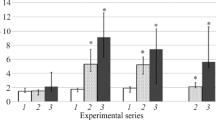Summary
In rats, guinea pigs, and mice, the activity of testicular esterases was studied with the following substrates: α-naphthyl acetate, naphthol-AS acetate,naphthol-AS-D acetate, and 5-bromo-indoxyl acetate. In all three species of animals, and with all substrates, not only Leydig cells but the remainder of the intertubular tissue were positive for esterases. The degree of the reaction changed with the species; α-naphthyl acetate yielded the strongest reaction. After estrogen treatment there was a clearcut reduction in esterase activity, especially in the mouse. One exception occurred in the rat where estrogen treatment enhanced the reaction with 5-bromo-indoxyl acetate.
In the rat and mouse, but not in the guinea pig, almost all procedures yielded esterase activity in the Sertoli cells. After estrogen treatment dye appeared in numerous fat droplets within cells of the seminiferous tubules. The Sertoli cells did not seem to react any more; but it is uncertain if they became truly negative.
Zusammenfassung
Bei normalen und oestrogen-behandelten Ratten, Meerschweinchen und Mäusen wurde die Esterasen-Aktivität des Hodens mit den Substraten α-Naphthyl-acetat, Naphthol-AS-acetat, Naphthol-AS-D-acetat und 5-Brom-Indoxyl-acetat untersucht. Es ergab sich:
-
A.
Intertubuläres Gewebe. 1. Bei allen drei Tierarten und allen Substraten war neben den Leydigzellen auch das übrige intertubuläre Gewebe Esterasen-positiv. Hinsichtlich der Stärke des Reaktionsausfalles bestehen beträchtliche Unterschiede zwischen den einzelnen Spezies. Die stärkste Reaktion wurde bei allen drei Tierarten mit der α-Naphthyl-acetat-Methode gefunden.
-
2.
Nach Oestrogenbehandlung nahm bei allen Tierarten die Esterasen-Aktivität deutlich im intertubulären Gewebe ab. Am stärksten war dies bei der Maus ausgeprägt. Eine Ausnahme hiervon ergab sich lediglich bei der Ratte nach Anwendung der 5-Brom-Indoxyl-acetat-Methode, wobei die Reaktion nach Oestrogenbehandlung verstärkt auftrat.
-
B.
Tubuli. 1. Bei Ratte und Maus, nicht dagegen beim Meerschweinchen, stellen sich bei fast allen Verfahren zum Esterasen-Nachweis die Sertolizellen dar.
-
2.
Nach Oestrogenbehandlung tritt in den Tubuli Farbstoff in zahlreichen Fettropfen zutage. Die Sertolizellen stellen sich, nicht mehr dar. Es muß offen bleiben, ob sie dabei tatsächlich negativ werden.
Similar content being viewed by others
Literatur
Arvy, L.: Histo-enzymologie des glandes endocrines. Paris: Gauthier-Villars 1963.
Barrnett, R. J.: The distribution of esterolytic activity in the tissues of the albino rat demonstrated with indoxyl-acetate. Anat. Rec. 114, 577–592 (1952).
Chessick, R. D.: Histochemical study of the distribution of esterases. J. Histochem. Cytochem. 1, 471–485 (1953).
Gössner, W.: Histochemischer Nachweis hydrolytischer Enzyme mit Hilfe der Azofarbstoffmethode. Untersuchungen zur Methodik und vergleichenden Histotopik der Esterasen und Phosphatasen bei Wirbeltieren. Histochemie 1, 49–96 (1958).
Gomori, G.: Distribution of lipase in the tissues under normal and pathologic conditions. Arch. Path. 41, 121–129 (1946).
—, and Chessick R. D.: Histochemical studies of the inhibition of esterases. J. cell. comp. Physiol. 41, 51–63 (1953).
Grünwald, P.: Structure of testes in infancy and in child hood. Arch. Path. 42, 35–48 (1946).
Hayashi, M. K., Ogata, T. Shiraogawa, Z. Murakami, and S. Tuneishi: The effect of unilateral and bilateral cryptochism upon the activities of β-glucoronidase, lipase and esterase in the testis. Acta path. jap. 8, 113–126 (1958).
Huggins, Ch., and St. H. Multon: Esterase of testis and other tissues. J. exp. Med. 88, 169–179 (1948).
Jirasek, J. E.: Die enzymatische Histochemie der Zwischenzellen in den Hoden menschlicher Embryonen. Acta histochem. (Jena) 13, 226–232 (1962).
Long, M. E., and E. T. Engle: Cytochemistry of the human testis. Ann. N. Y. Acad. Sci. 55, 619–628(1952).
Mancini, R. E., J. Nalazco, and E. A. de la Balze: Histochemical study of normal adult human testes. Anat. Rec. 114, 127–147 (1952).
Markert, C. L., and R. L. Hunter: The distribution of esterase in mouse tissues. J. Histoehem. Cytochem. 7, 42–49 (1959).
McEnery, W. B., and W. O. Nelson: Cytochemical studies of the testes of rats. Anat.Rec. 109, 324 (1950).
Nachlas, M. M., and A. Seligman: The comparative distribution of esterase in the tissues of five mammals by a histochemical technique. Anat. Rec. 105, 677–696 (1949).
Niemi, M., M. Härkönen, and A. Kokko: Localization and identification of testicular esterases in the rat. J. Histochem. Cytochem. 10, 186–193 (1962).
Pearse, A. G. E.: Histochemistry. Theoretical and applied. J. A. Churchill Ltd., London 1961.
Tonutti, E.: Zur Histophysiologie der Leydigschen Zwischenzellen. Z. Zellforsch. 32, 495–516 (1943).
—: Über die Strukturelemente des Hodens und ihr Verhalten unter experimentellen Bedingungen. In: Zentrale Steuerung der Sexualfunktionen. Die Keimdrüsen des Mannes. I. Sympos. der Dtsch. Ges. f. Endokrinol. Berlin-Göttingen-Heidelberg: Springer 1955.
— O. Weller, E. Schuchardt u. E. Heinke: Die männliche Keimdrüse. Stuttgart: Georg Thieme 1960
Verne, J., et S. Hebert: L'activité estérasique des cellules interstitielles du testicule et d'épididyme chez le rat. Ann. Endocr. (Paris) 13, 924–930 (1952).
Williams, R. G.: Studies of living interstitial cells and pieces of semiferous tubules in autogenous grafts of testes. Amer. J. Anat. 86, 343–370 (1950).
Author information
Authors and Affiliations
Additional information
Herrn Prof. Dr. W. Bargmann zum 60. Geburtstag gewidmet.
Mit Unterstützung der Deutschen Forschungsgemeinschaft. — Für technische Unterstützung danken wir Frl. U. Striebeck.
Rights and permissions
About this article
Cite this article
Baust, P., Goslar, H.G. & Tonutti, E. Das Verhalten der Esterasen im Hoden von Ratte, Maus und Meerschweinchen nach Oestrogenbehandlung. Z.Zellforsch 69, 686–698 (1966). https://doi.org/10.1007/BF00406308
Received:
Issue Date:
DOI: https://doi.org/10.1007/BF00406308



